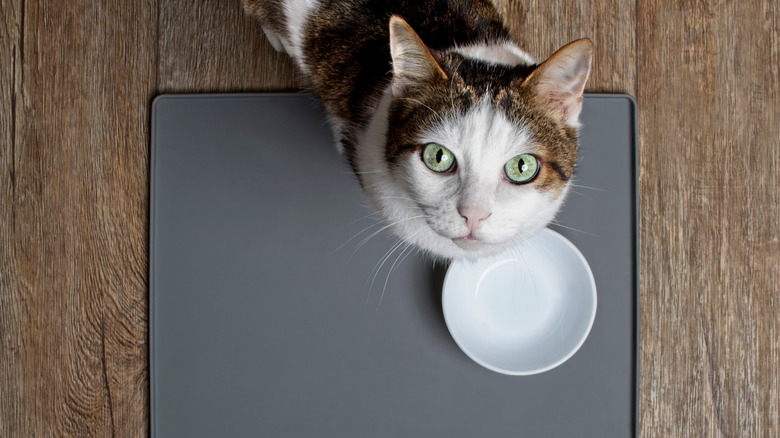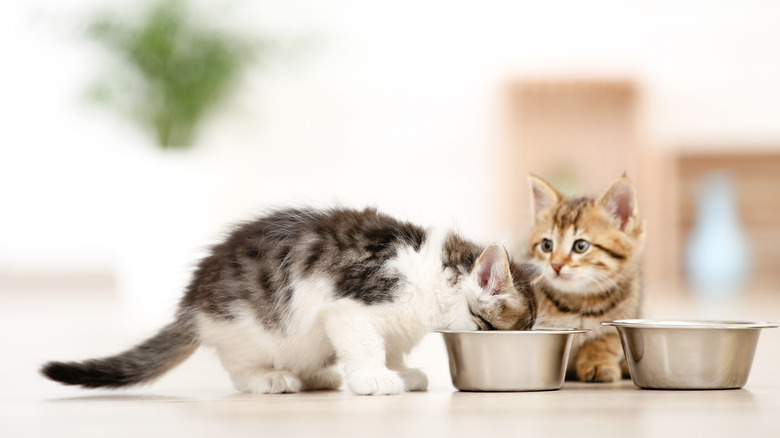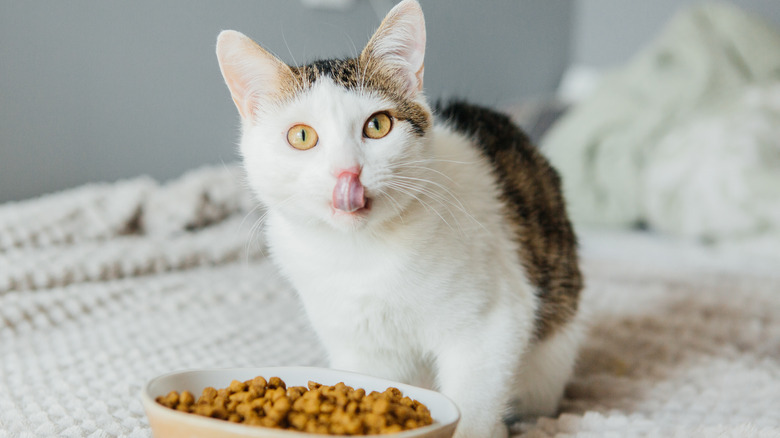How To Keep Your Cat From Eating Too Fast
If your cat comes speeding across the house when she hears food being poured into her bowl, and then immediately inhales all the food at once in a panic, you may have noticed it doesn't seem to see too well in her belly when she's finished. Often, when a cat eats its meal too quickly, it will regurgitate the food (via Pet MD). While this is not only unpleasant for the humans who have to clean up the mess, it also leaves your cat still unfed and hungry, and possibly stressed out.
Some cats may have always had this bad habit, while others may have learned it as a survival technique if they spent part of their lives feral, without reliable access to food, or in a crowded place where food had to be fought for. Now that your kitty is safely and happily in your home and being fed regularly, there are ways you can help her slow down her eating. Better eating habits can benefit her health in multiple ways, and also hopefully leave you fewer messes to clean up.
Some techniques to try
If you have a multi-cat household, it's possible that the cat who is eating too fast is doing so because she feels there is competition for the food and is trying to get her share before she can't. The first line of defense in this case is to simply feed the cats in separate rooms and keep their food bowls away from each other at all times (via Outward Hound). Over time, as the anxious cat gets used to being fed on her own, without anyone competing for her food, she may naturally calm down and eat more slowly. Be patient, as this can be a process, but hopefully her eating habits become more relaxed as this routine becomes ingrained.
If the multi-cat household doesn't seem to be the issue, then another potential fix is reconsidering the type of food you are feeding your cat. Cats are less likely to overeat wet food than dry food, and because wet food doesn't expand in their bellies the way dry food does, it is also less likely to cause the cat to throw up. If, however, dry food is the preference, then consider serving it to your cat spread out on a baking tray rather than in a bowl. While this might seem funny, spreading out the individual kernels of food over a large surface rather than piling it together in a bowl will slow your cat down by necessity, causing her to take smaller bites.
Other solutions to try
Baking pans aren't the only option for switching up the container you use to feed your cat. You could consider a bowl designed with obstructions specifically aimed at slowing your cat down as she eats (via Sure Pet Care). Bowls made with ridges and bumps in the bottom make it harder for your cat to get too much food at one time. Similarly, you could put an obstruction in the bowl yourself, like a golf ball. That might sound odd, but placing something like a golf ball right in the center of the bowl will force your cat to eat around it and move more slowly.
You could also try turning feeding time into playtime with a feeder that encourages your cat to open different parts of the toy feeder to reach food. This way, she doesn't have access to all the food at once, and has to slow down to open each door or section. Turning feeding time into play can also shift an anxious cat's perspective on what she's doing. Rather than eating all at once in a panic, she is playing and being rewarded each time she figures something out.
Adding water to dry food will also slow your cat's eating down a bit, and it will pre-expand the food as well, so rather than the cat eating small pellets that expand later and make her sick, she has a better sense of how much she is eating right away.


